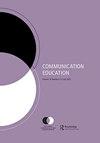回答:为什么教学传播学学者应该使用准确、适用和包容的方法
IF 0.8
Q3 COMMUNICATION
引用次数: 0
摘要
我必须首先赞扬所有论坛作者在这里所做的贡献。这五篇文章应该引起讨论,远远超过了他们的简短,虽然在不同的主题,但他们仍然在重要的方面相互联系和交叉。我将在这篇文章中探讨这些交叉点,找出大多数或所有文章中出现的主题。由此,我将考虑这些文章隐含的主题——有人可能会说,隐藏在它们之间的阴影中——这些主题可能会进一步阐述本论坛的重要主张。五篇文章中的三篇主要关注我们如何使用研究方法,这三篇文章都强调了如何使用研究方法的一个具体方面。Brammer等人关注实际应用,考虑研究人员和实践者如何利用研究方法参与评估。Johnson强调了准确性和完整性,强调了数据收集过程和对缺失的处理可能会使获得的结果产生偏差。Kelly等人以包容性为中心,详细阐述了研究实践如何系统地关注某些群体,而排斥其他群体。虽然每篇文章都强调一个特定的主题,但这三个主题贯穿了所有三篇文章。例如,Brammer等人权衡了由于忽视残疾学生的经历(包容)而可能产生的评估偏差(准确性),Johnson考虑了减轻参与者的研究负担(包容),同时持续关注沟通与学习之间的联系(应用)。这种主题的交织是有意义的,因为按照Kelly等人的观点,包容性的方法会导致更准确/完整的结果,这对有效的教学实践至关重要。剩下的两篇文章关注的是教学交流学者可能使用的方法。具体来说,每一篇文章都提出了一种教学传播学学者所忽视的方法论方法。值得注意的是,这两篇文章也重复了三篇文章中所考虑的主题。Goodboy和他的同事讨论了混合建模作为一种方法,可以揭示隐藏在数据中的群体,被其他方法(如一般线性模型)所掩盖。从某种意义上说,这在定量语言中重塑了Kelly等人的论点,提供了一种工具,定量学者可以借此调查那些在大多数人的统计数据下可能被忽略的群体。毫无疑问,对学生群体更清晰的了解应该会促进实践的实际应用,从而提高学习效果(Brammer等)。本文章由计算机程序翻译,如有差异,请以英文原文为准。
Response: why instructional communication scholars should use accurate, applicable, and inclusive methodologies
I must start by commending all forum authors for their contributions here. These five essays should provoke discussion that far exceeds their brevity, and although diverse in topic, they nevertheless cohere and intersect with each other in important ways. It is these intersections I will explore in this response, identifying themes that appear in most or all of the essays. From this, I will consider topics implied by these essays—one might say, that lie in the shadows between them—that might further elaborate the important claims in this forum. Three of the five essays primarily focus on how we use research methods, with each of those three emphasizing a specific aspect of that how. Brammer et al. focus on practical application, considering how researchers and practitioners might leverage research methods to engage in assessment. Johnson highlights accuracy and completeness, underscoring how data collection procedures and handling of missingness may bias obtained results. And Kelly et al. center inclusion, elaborating how research practices have systematically spotlighted some groups while excluding others. Although each essay places emphasis on a particular theme, all three themes cut across all three essays. For example, Brammer et al. weigh assessment biases (accuracy) that might arise from ignoring the experiences of students with disabilities (inclusion), and Johnson considers the reduction of research burden for participants (inclusion) while continually focusing on the link between communication and learning (application). This weaving of themes makes sense because, following Kelly et al., inclusive methodologies lead to more accurate/complete results, which is crucial for effective instructional practice. The remaining two essays focus on whatmethods instructional communication scholars might use. Specifically, each of these essays advances a methodological approach that instructional communication scholars have ignored. Of note, these two also repeat the themes considered in the three how essays. Goodboy and his colleagues discuss mixture modeling as an approach that can reveal groups hidden in the data, obscured by other approaches (such as the general linear model). In some sense, this recasts the argument of Kelly et al. in quantitative language, providing a tool whereby quantitative scholars can investigate groups whose experiences might be rendered invisible beneath statistics that aggregate across the majority. Without question, a clearer understanding of student groups should foster practical application of practices that enhance learning (Brammer et al.).
求助全文
通过发布文献求助,成功后即可免费获取论文全文。
去求助
来源期刊

COMMUNICATION EDUCATION
EDUCATION & EDUCATIONAL RESEARCH-
CiteScore
3.10
自引率
34.80%
发文量
47
期刊介绍:
Communication Education is a peer-reviewed publication of the National Communication Association. Communication Education publishes original scholarship that advances understanding of the role of communication in the teaching and learning process in diverse spaces, structures, and interactions, within and outside of academia. Communication Education welcomes scholarship from diverse perspectives and methodologies, including quantitative, qualitative, and critical/textual approaches. All submissions must be methodologically rigorous and theoretically grounded and geared toward advancing knowledge production in communication, teaching, and learning. Scholarship in Communication Education addresses the intersections of communication, teaching, and learning related to topics and contexts that include but are not limited to: • student/teacher relationships • student/teacher characteristics • student/teacher identity construction • student learning outcomes • student engagement • diversity, inclusion, and difference • social justice • instructional technology/social media • the basic communication course • service learning • communication across the curriculum • communication instruction in business and the professions • communication instruction in civic arenas In addition to articles, the journal will publish occasional scholarly exchanges on topics related to communication, teaching, and learning, such as: • Analytic review articles: agenda-setting pieces including examinations of key questions about the field • Forum essays: themed pieces for dialogue or debate on current communication, teaching, and learning issues
 求助内容:
求助内容: 应助结果提醒方式:
应助结果提醒方式:


